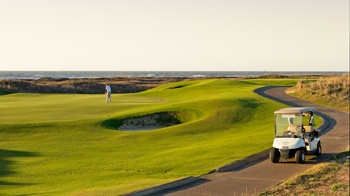Wind-whipped ocean waves slap the shore just beyond the sand dunes. A squadron of Brown Pelicans hovers overhead as if suspended from the clouds by invisible strings. Eco-conscious golfers teeing it up for 18 holes at Newport Dunes Golf Club, a privately owned course open daily to the public, are enjoying a round at Texas’ latest golf course designed to provide a unique golfing challenge with a nod to the environment. The Scottish links-style course, which opened in September 2008 on Mustang Island in Port Aransas, is one of the state’s most conservation-minded layouts and the first Arnold Palmer-designed course on the entire Gulf Coast.
The golf club has applied to join an elite group of only 14 Texas courses certified by Audubon International, a nonprofit organization dedicated to protecting and sustaining the natural environment. This select group of golf courses, which represents less than 2 percent of the 800-plus public and private courses in Texas, has chosen to address age-old criticisms about golf courses being water hogs, altering natural habitat and serving as major sources of pollution. The course has “pledged to take steps to protect and sustain the land, water, wildlife and natural resources on the property,” says Audubon International program manager Joellen Lampman. Audubon International is not affiliated with the National Audubon Society, which focuses on birds and other wildlife.
Newport Dunes developer Texas Gulf & Harbor Ltd. sculpted the treeless but verdant, rolling public golf course out of 200 acres of sun-baked coastal flats between beach access roads 1 and 1A along Texas Highway 361. The first three holes were built on the bay side of the highway, while the other 15 are between the highway and the sand dunes that front the Gulf of Mexico.
“The land looked pretty barren before the golf course went in,” golf course Superintendent Jim Brown says. “When we first came out and looked at the site, it looked like we were in Antarctica or somewhere. All the dunes you see on the course were put in with excavated soil.”
Newport Dunes golfers face stiff coastal winds, undulating fairways populated by deep, stacked-wall bunkers, tightly mowed approaches and fast, rolling greens. Errant shots often end up in rough dominated by mounds of native vegetation and manmade sand dunes, some 15 feet high.
Developers hauled in 800,000 cubic yards of sand to form the course that primarily consists of mounded fairways and hybrid Bermuda greens framed by native habitat planted with coastal vegetation such as sea oats and cordgrass, prickly pear cacti and lots of Gulf Coast muhly grass. In all, some 40,000 low-maintenance ornamental plants and native grasses were planted.
Small lakes feature buffer zones of native vegetation that filters contaminants from runoff and serves as cover for wading birds, jackrabbits and other wildlife.
One eco-friendly feature that may well be unique to Texas golf courses, according to Brown, is the extensive drainage system built beneath the fairways on the back nine. It captures irrigation runoff that is pumped into a giant holding tank for reuse. The closed-loop system recycles water to conserve every precious drop.
A weather station at the course’s maintenance facility collects climatological data and transmits evapotranspiration (water loss in soil) data to Brown’s computer. Using special software, Brown can tell all 1,780 sprinkler heads how much water to dispense and how long to irrigate the fairways. As a result, irrigation, including effluent water and electricity fees, accounts for only 20 percent of operational and maintenance costs. Chemical costs account for only 5 percent of Newport’s budget.
Fairways are sodded with seashore paspalum, a salt-tolerant, warm-weather turf. The grass can thrive on highly marginal irrigation water and outcompetes most weeds, negating the need for most herbicide applications.
The same computerized irrigation system saves water at Barton Creek Resort’s Fazio Canyons golf course just west of Austin. The private course, along with Arlington’s public Tierra Verde Golf Club, are the only Texas courses to have earned certification in the elite Audubon International Bronze Signature Program, which sets a higher bar for comprehensive environmental planning.
Barton Creek’s Fazio Canyons are integrated into the surrounding environment. The course features picture-book views of limestone canyons from elevated tee boxes and breathtakingly beautiful holes carved out of the oak and juniper woodlands of the Balcones Escarpment. Crystal-clear Lost Creek snakes its way through the hilly terrain on a number of holes, providing a hazard for players, but a necessary water source for wildlife such as cottontail rabbits and roadrunners.
At several spots on this jewel of a course sitting atop the Edwards Aquifer, signs near environmentally sensitive riparian and nesting areas of endangered songbirds denote “Wildlife area: Please do not disturb.” One hillside sign above the No. 13 tee box identifies a majestic Texas madrone, a showy tree species whose range stretches from Central Texas to Guatemala.
Fazio Canyons, like Newport Dunes, uses local water district effluent for irrigation, diverting it from surrounding creeks, rivers and lakes.
Tierra Verde Golf Club, as well, emphasizes wildlife conservation, water-quality protection, integrated pest management that reduces the use of poisonous chemicals and other eco-friendly practices. It’s not unusual for players to spot Wild Turkey, Wood Ducks, roadrunners and the occasional bobcat in the urban oasis that places a premium on wildlife habitat.
Now, eco-minded golfers have a choice of playing a growing number of Texas courses where their conservation ethics won’t conflict with their choice of recreation.
——————–
Rob McCorkle wrote about the olive oil industry in the August 2008 issue of Texas Co-op Power.


